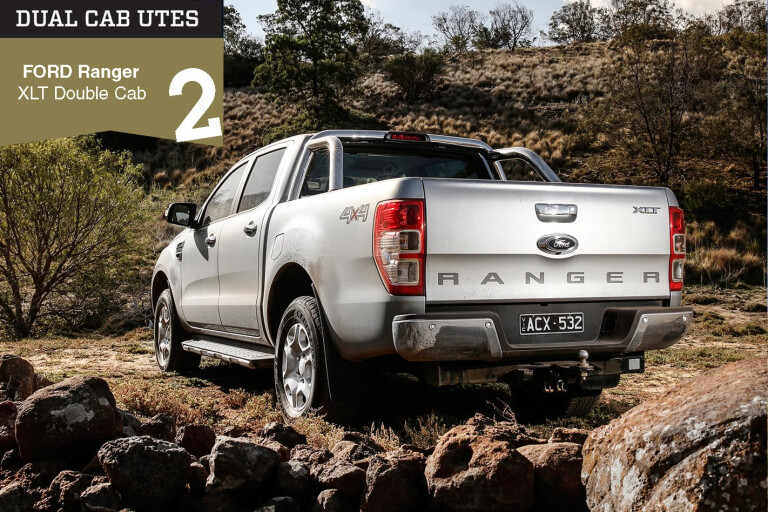
There’s never been a better time to review the dual-cab 4x4 class of 2016 than right now. Wheels pitches eight of the biggest sellers in the segment for the title of King of the Heap. Here's number two, the Ford Ranger.
First published in the May 2016 issue of Wheels magazine, Australia's best car mag since 1953.
WHILE it was once possible to consider the Mazda BT-50 and Ford Ranger the same, a 2015 facelift introduced noticeable mechanical and cosmetic differences.
Unlike previous Mazda/Ford joint developments, which were mostly the work of the Japanese brand, the Ranger was engineered by Ford in Australia, is built in Thailand, and up until recently differed only in its spring rates, which were slightly softer than in the Mazda.
In the facelifted Ranger, the biggest departure is evident as soon as you turn the wheel. A new electric power steering system (the BT-50 retains the old hydraulic system) provides light, smooth steering at parking speeds. It’s at odds with the butch look but isn’t a bad thing, making the Ford easy to wheel around the suburbs.
As speeds rise, the weighting becomes more natural, without the wheel losing its lovely, frictionless feel. This steering system is where the Ranger stands head and shoulders above its rivals, providing a great sense of connection that encourages you to push on, which few utes do.
But there’s more than one area in which the Ford ute stamps its authority on the segment. The Ranger’s 147kW/470Nm outputs are impressive and translate to the real world, where the Ford keeps company with Navara and Colorado from 0-100km/h (10.5sec) and 80-120km/h (7.7sec), while feeling more effortless in most everyday – and off-road – scenarios. To top it off, the 3.2-litre five-pot sounds throaty and has gained refinement thanks to quieter new injectors and cylinder-head revisions as part of last year’s facelift.
Although near-identical twins until recently – and despite the Mazda’s price advantage – the Ranger has historically sold twice as many as its sibling. Would you believe it’s all down to image and aesthetics? And we thought passenger car buyers were a superficial bunch…
However, while both vehicles are equally terrific in terms of refinement, there are real reasons to choose the Ford over the Mazda, such as the Ranger’s more compliant ride on bitumen surfaces.
From the front seats, the other difference is obvious. While the Mazda is relatively sleek and car-like, the Ranger has a dash that drawls ‘Yank truck’, which fits perfectly with its pervading image.
As in the BT-50, the Ranger’s rear compartment is roomy and has terrific legroom thanks to its long 3220mm wheelbase and sculpted front-seat backs. It’s still upright, but at least rear occupants get air-conditioning vents, a centre armrest with cupholders, big bottle-holders in the doors and 12V and 230V outlets.
Off the beaten track, the big Ford takes it all in its broad stride, dismissing even the most challenging climbs with insouciance and a minimum of wheelspin. It’s not quite as accomplished as the Hilux – nor as much of a known quantity long-term – and it’s not quite up to the urban polish of the new-school Amarok, but the Ranger will take you just about anywhere you’d expect with a standard roadgoing 4x4.
You can tell that much about the Ford by looking at it. Just ask anyone who’s ever overlooked the Mazda BT-50.
Off-road performance
Ranger’s muscular 3.2-litre five-cylinder turbo-diesel is a terrific basis for an off-road-capable ute with class-leading load capacities of 3500kg braked and 750kg unbraked. The fact the engine draws intake air from inside the front guard helps deliver a superior wading depth compared with those utes with under-bonnet air pick-ups. The Ranger also boasts a generous 237mm ground clearance, which lets you go further before snagging its undercarriage. The updated version’s revised traction control ensures solid climbing credentials and stays activated across the front axle when the rear diff lock is engaged.
 SPECS
SPECS
Model: Ford Ranger XLT Double Cab
Price as tested: $56,590
Engine: 3198cc 5cyl, dohc, 20v, TD
Power: 147kW @ 3000rpm
Torque: 470Nm @ 1500-2750rpm
Transmission: 6-speed automatic
Dimensions (L/W/H/W-B): 5351/1850/1821/3220mm
Weight: 2159kg
Tray capacity: 1041kg
Braked towing capacity: 3500kg
Unbraked towing capacity: 750kg
Ground clearance: 237mm
Tyres: Dunlop AT22 Grandtrek 265/65R17
ADR81 fuel consumption: 9.2L/100km
0-100km/h: 10.5sec
0-400m: 17.6sec @ 128.3km/h
80-120km/h: 7.7sec
3yr resale: 65%
Plus: Slick steering; spacious cabin; grunty five-cylinder diesel; on- and off-road polish
Minus: Pricey; relatively thirsty

COMMENTS